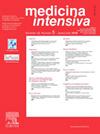Comparison of non-invasive ventilation on bilevel pressure mode and CPAP in the treatment of COVID-19 related acute respiratory failure. A propensity score–matched analysis
IF 3.1
4区 医学
Q2 CRITICAL CARE MEDICINE
引用次数: 0
Abstract
Objective
The purpose of this study was to analyze the differences in the effectiveness and complications of CPAP versus non-invasive ventilation on bilevel positive airway pressure (BiPAP) in the treatment of COVID-19 associated acute respiratory failure (ARF).
Design
Retrospective observational study.
Setting
ICU.
Patients
All COVID-19 patients, admitted to an ICU between March 2020 and February 2023, who required CPAP or BiPAP were analyzed.
Interventions
Use of CPAP or BiPAP in COVID-19 associated ARF.
Main variables of interest
Initial clinical variables, CPAP and BiPAP failure rate, complications, in-hospital mortality.
Results
429 patients were analyzed, of whom 328 (76.5%) initially received CPAP and 101 (23.5%) BiPAP. Initial respiratory rate was 30 ± 8 in the CPAP group and 34 ± 9 in BiPAP (p < 0.001), while PaO2/FiO2 was 120 ± 26 and 111 ± 24 mmHg (p = 0.001), respectively. The most frequent complication related to the device was claustrophobia/discomfort, 23.2% in CPAP and 25.7% in BiPAP (p = 0.596), while the most frequent complications not related to the device were severe ARDS, 58.6% and 70.1% (p = 0.044), and hyperglycemia, 44.5% and 37.6%, respectively (p = 0.221). After adjusting by propensity score matched analysis, neither failure of the device (OR 1.37, CI 95% 0.72–2.62) nor in-hospital mortality (OR 1.57, CI 95% 0.73–3.42) differed between both groups.
Conclusions
Either non-invasive ventilatory device failure or mortality rate differed in patients initially treated with CPAP versus BiPAP.
双水平压力模式无创通气与CPAP治疗COVID-19相关急性呼吸衰竭的比较倾向评分匹配分析
目的分析双水平气道正压通气(BiPAP)与无创通气治疗COVID-19相关急性呼吸衰竭(ARF)的疗效及并发症的差异。设计:回顾性观察性研究设置:ICU患者分析2020年3月至2023年2月期间入住ICU的所有需要CPAP或BiPAP的COVID-19患者。CPAP或BiPAP在COVID-19相关ARF中的干预作用主要感兴趣的变量初始临床变量,CPAP和BiPAP失败率,并发症,住院死亡率。结果共分析429例患者,其中328例(76.5%)首次接受CPAP, 101例(23.5%)首次接受BiPAP。最初的呼吸速率是30 ±8 CPAP组和34 ± 9 BiPAP (p & lt; 0.001),而PaO2 /供给120 ± 26日和111年 ± 24 毫米汞柱(p = 0.001),分别。与设备相关的最常见并发症为幽闭恐惧症/不适,CPAP为23.2%,BiPAP为25.7% (p = 0.596),与设备无关的最常见并发症为严重ARDS,分别为58.6%和70.1% (p = 0.044),高血糖症,分别为44.5%和37.6% (p = 0.221)。经倾向评分匹配分析调整后,两组间装置失效(OR 1.37, CI 95% 0.72-2.62)和住院死亡率(OR 1.57, CI 95% 0.73-3.42)均无差异。结论初始采用CPAP与BiPAP治疗的患者无创通气装置失效或死亡率存在差异。
本文章由计算机程序翻译,如有差异,请以英文原文为准。
求助全文
约1分钟内获得全文
求助全文
来源期刊

Medicina Intensiva
CRITICAL CARE MEDICINE-
CiteScore
2.70
自引率
20.00%
发文量
146
审稿时长
33 days
期刊介绍:
Medicina Intensiva is the journal of the Spanish Society of Intensive Care Medicine and Coronary Units (SEMICYUC) and of Pan American and Iberian Federation of Societies of Intensive and Critical Care Medicine. Medicina Intensiva has become the reference publication in Spanish in its field. The journal mainly publishes Original Articles, Reviews, Clinical Notes, Consensus Documents, Images, and other information relevant to the specialty. All works go through a rigorous selection process. The journal accepts submissions of articles in English and in Spanish languages. The journal follows the publication requirements of the International Committee of Medical Journal Editors (ICMJE) and the Committee on Publication Ethics (COPE).
 求助内容:
求助内容: 应助结果提醒方式:
应助结果提醒方式:


